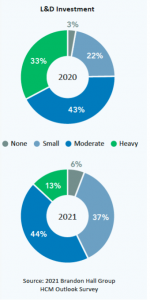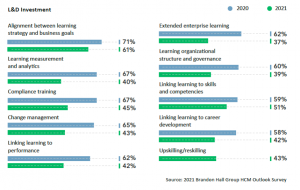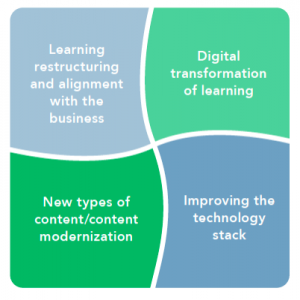
The year 2020 used to be emblematic as a beacon of the future, with countless papers, reports, and articles predicting what it would bring. Now, having lived through it, it is quite clear it did not turn out the way anyone expected.
And that one endless year has implications for organizations far into the future, beyond its duration. As the dust is in the midst of settling, it’s important to reflect on what happened and what learning will look like in 2021—and beyond.
The silver lining to 2020’s volatility, uncertainty, and disruption is that Learning leaders were forced to smash through the roadblocks and bottlenecks that were preventing them from taking on real digital transformation. Companies were thinking about it, experimenting with it, and dabbling in various types of learning technologies for years, but few had made a real shift from a strategy of traditional classes and courses. But it looks like that is now behind us.
The research conducted by Brandon Hall through the end of 2020 paints a picture of shifting priorities and a renewed focus on making learning agile and adaptable to meet the future needs of the business.
According to survey respondents, some of the ways learning and development (L&D) is stronger include:
- Forced transformation and innovation
- Better business alignment and collaboration
- Agility
- Better use and alignment of learning technology
- The increased perceived value of learning by C-suite executives
The pandemic had an indelible impact on learning functions and how they operate. Nearly half of companies in Brandon Hall Group’s 2020 L&D Benchmarking Study said their per-learner budgets had decreased because of COVID-19. Additionally, investment in L&D is set to drop off as we look ahead.
Back in 2019, when COVID-19 was unknown, Brandon Hall Group’s HCM Outlook Study found that more than three-quarters were planning to make moderate to heavy investments in L&D for 2020. A year later, deep into the pandemic and looking toward 2021, that number dropped to 57 percent.

Investment in L&D is falling, as companies pull back some of the time, money, and focus they put into the various aspects of L&D.

Though overall investment may not be as strong as it was before, it does not mean it will become nonexistent. Organizations are learning they need to do more with less and are rethinking their investments. As companies devise their return-to-work strategies, it remains clear there will be more remote employees than there were before 2020. Before stay-at-home orders and advisories were issued, only 15 percent of organizations reported that more than half of their workforce was remote. Once their return-to-work strategies roll out, that number doubles to 30 percent.
Organizations have always gone through phases of “do more with less.” The pandemic environment has taken that to extremes many have not faced, however. Budgets were impacted immediately, while companies simultaneously needed to re-engineer how learning is delivered and the technologies it requires. As companies look beyond the pandemic, their learning and development priorities have shifted.
When asked about their specific L&D priorities for 2021, responses typically fell into one of several areas:

Emerging from the Pandemic
Organizations must recover and they need to do it quickly. This “recovery at work speed” is essentially built on five key pillars or stages:
- Reinventing/communicating: Maintaining strong communications across your enterprise, especially with a new cadre of remote employees.
- Reopening: As the pandemic eases off, places such as stores, service centers, call centers, offices, clinics, schools, etc., will need to reopen.
- Reviving: Launching new products and services and getting back up and running are critical.
- Reskilling: Changing business conditions will most likely require new skills and priorities.
- Reboarding: Rehiring employees that were let go, as well as bringing new talent on board.
All five stages of the recovery require highly memorable, relevant, contextual and accessible digital content that can be stretched to fit the volatile, uncertain, complex, and ambiguous (VUCA) pandemic world. The biggest priority of the five pillars is reskilling, with more than two-thirds of companies identifying this as a top priority.
1. Reinventing/Communicating
Brandon Hall Group’s Transitioning to the New Realities of the COVID-19 Pandemic study found that one of the most important business transitions companies face is managing change. The importance of managing change only increased as the pandemic wore on. Learning plays a critical role in managing change, and learning agility becomes critical when the changes are large and come fast. During the pandemic and the spotty recovery, companies have gone through various stages of recovery and certain areas grew in importance. From May 2020 to July 2020 the focus and importance of communicating to employees across the enterprise throughout the pandemic grew by 31 percent. With a newly dispersed workforce, communication became both critical and challenging at the same time.
2. Reboarding
The importance of reboarding employees increased 12 percent. Companies have begun to decide who to bring back from furloughs and layoffs. Some sectors and companies experienced growth during the pandemic which requires them to onboard/hire new employees. The onboarding/reboarding process has changed substantially as a result of the pandemic and requires new approaches and technology.
3. Reopening
The next logical phase of recovering from the economic/business impacts of the pandemic is to reopen businesses and locations. This is also one of the top five areas of increased focus from the Brandon Hall Group study. To reopen, many organizations had to adjust policies, procedures, and processes to ensure the safety of employees and customers.
4. Reskilling/Refreshing
The next step in recovery is the possible need to reskill employees, whether it is reskilling employees to fill gaps made by laid-off or furloughed employees, or reskill employees to deal with new products, services and processes. Many workers must be reminded or refreshed on how to do things, especially in the COVID-19 environment, as opposed to learning or developing new skills.
5. Reviving
The final step in recovery at workspeed is reviving your business by introducing new products, services and sales/business models based on changing conditions and the pandemic. A great example is in the healthcare and life sciences industries, where they were on the front lines of diagnosis and treatment of COVID-19. This required organizations to quickly adapt and innovate on standards of care and new technologies, medical devices, drugs, tests and procedures to fight the pandemic. This required training and lots of it.
Click here for information on Brandon Hall Group’s Professional Certification Program




